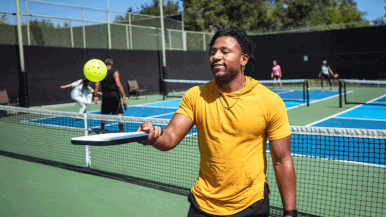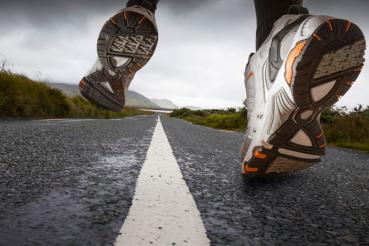Pickleball, the game that sounds like it might make for a crunchy sandwich topping, is one of the fastest growing sports in the United States. “It’s quickly becoming a sport of choice for adults over the age of 50,” says Brian Cole, MD, an orthopedic surgeon and sports medicine specialist at RUSH.
With that rise in popularity, there has also been a rise in the number of pickleball-related injuries.
Pickleball is a bit of a middle ground between tennis and ping pong. The rules are fairly simple, and players of almost any age and skill level can enjoy the game.
But the fact that the sport is so welcoming to beginners and seniors may also be why there has been such a steep increase in pickleball-related injuries.
“The high injury rate can be attributed to the fact that most players tend to be over 50,” says Cole, who plays pickleball. “And many of them were largely sedentary before picking up their pickleball paddles.”
Some of the most common injuries Cole sees are strains and sprains, mostly in the legs and ankles, as well as rotator cuff injuries. Sometimes he sees more serious problems, like fractures and concussions.
Whether you’re a senior picking up a paddle for the first time, or you’re a competitive player climbing the ranks in your tournament, Cole has a few tips to help you prevent injuries while you enjoy pickleball.
1. Find out how healthy you are
While pickleball is a beginner-friendly sport, it still requires a good deal of physical activity. If you haven’t been very active in a while, you may not be as prepared to play as you think.
This is especially true for older players. “Patients over 60 account for nearly 80% of pickleball injuries, and most of them are male,” says Cole.
Part of the problem is that many people, seniors in particular, have underlying conditions they don’t know about. Those conditions can put you at risk for injury.
“Millions of people walk around with rotator cuff tears but have no pain because they’re well adapted,” Cole says. “But then they go out, adopt this new sport, and they do some funky move that puts them over the edge, and they become symptomatic. And that’s when things kind of spiral.”
Before you start playing, schedule an appointment with your primary care physician to check on your health. You may also want to make an appointment with a physical therapist who can screen you for pre-existing injuries and conditions that you might not know about.
“Because it’s an older population in many instances, there’s a lot of preexisting disease that is pretty quiescent until people achieve a high level of activity,” Cole says. “Then they aggravate these conditions, such as underlying arthritis, and they come in with a painful swollen knee or loss of motion.”
2. Do warm-up exercises
Before you start any athletic activity, warming up will help you get ready and prevent injury.
“For our older patients, a dynamic warm-up is pretty important,” Cole says. “Doing some type of exercise prep beforehand makes a big difference to prevent injury.”
Cole recommends starting with a 10-minute warm-up that should begin with some jogging or jumping jacks.
Next, do some arm circles and shoulder rotations. You probably did these in gym class as a kid. Hold your arms straight out from your sides and rotate them in small circles, then gradually make bigger circles before rotating in the opposite direction. Then stick your arms in front of you and rotate your shoulders forward and back.
Finish up with some leg swings. Stand next to a wall for support, then swing one leg back and forth, then side to side. Repeat those steps with your other leg.
These exercises will get your heart rate up and get blood flowing to your muscles, which can prevent injury.
3. Work on your coordination
A lot of pickleball injuries happen in the lower extremities, meaning the legs, ankles and feet. If you’re not well balanced and coordinated, you could be at higher risk for tripping and falling.
“Effective footwork is crucial for maintaining balance, agility and positioning on the pickleball court,” Cole says. “Unskilled footwork will decrease your skills and may be responsible for the most common pickleball injuries.”
To improve your coordination, Cole recommends running a few drills that should only take about 15 minutes. First is the side-to-side shuffle. Stand with your feet shoulder-width apart, then quickly move side to side.
Next is the cross-step drill. Start again with your feet shoulder-width apart. Cross one leg in front of the other diagonally. Then quickly move your back leg out from behind the front leg to return to the position you started in. Keep moving side-to-side, crossing and uncrossing your legs in this way.
These will help you get used to some of the motions you’ll be making during the game, and you’ll have an easier time avoiding falls.
4. Get the right gear
Pickleball may seem like it only requires a net, paddle and ball. But there are more things to consider and a few other items you should pick up to help you stay safe.
First, make sure your paddle is appropriate for your strength level. You’ll be swinging it a lot, so it shouldn’t cause your arm to feel tired or overworked. Some paddles weigh less than others, and these may suit you better.
“Lightweight paddles offer less strain and fatigue in your arms as they weigh 7.5 ounces and less,” Cole says.
You’ll also need the right shoes, and the type of shoes you need depends on the court you will play on.
“There are shoes for an indoor game and another type for an outdoor game,” Cole says. “Shoes for outdoor games should be durable enough for the surface of the court. They typically have a modified herringbone pattern that optimizes the combination of give and grip. Indoor shoes have softer, thinner, lighter outsoles, so they’re best for hardwood surfaces.”
Having extra socks on hand will also help prevent blisters and foot injuries.
Finally, if you are playing outdoors, consider what type of sun protection you’ll need. Sunglasses will protect you from eye damage, and you may want to consider a pair with a strap or cord that will keep them in place during play.
Sunscreen is also important for preventing sun damage and skin cancer. “Choose a sunscreen with an SPF of 50 or above when playing on an outdoor court,” Cole says.
5. Take a lesson
Many clubs and park districts offer pickleball lessons to players of all skill levels. Classes can help you improve your technique and stay safe on the court.
“Some would argue that pickleball is a sport that is more about strategy than physical ability, including strength and conditioning,” Cole says. “To be good at any age and stay injury free, take a lesson. Not only will you beat your opponent, but you will be more likely to stay in the game.”
Pickleball can have so many benefits for anyone who plays, including seniors. It can improve your mental health, promote healthy aging, lower the risk of chronic disease and even boost your social life.
“It actually provides a pretty good overall body workout,” Cole says. “It can help with balance, agility, reflexes and hand-eye coordination, and it doesn’t put excessive strain or stress on our bodies.”
Just make sure to stay safe while you’re on the court. Taking a few simple steps can keep you from a trip to the orthopedist and keep you paddling.




